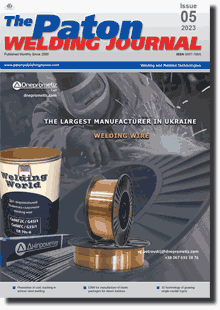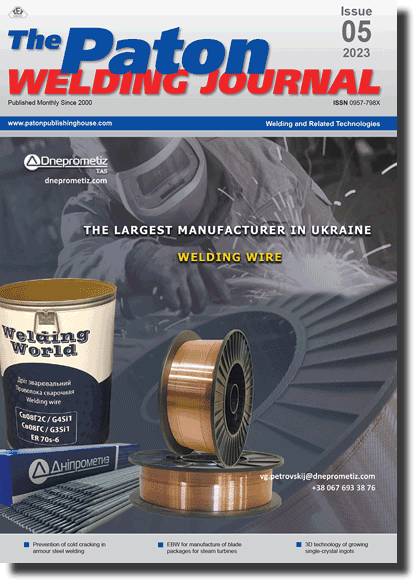| 2023 №05 (02) |
DOI of Article 10.37434/tpwj2023.05.03 |
2023 №05 (04) |

The Paton Welding Journal, 2023, #5, 15-21 pages
Analysis of causes of failure of site welded butt joints of main pipelines after long-term operation
L.I. Nyrkova, L.V. Goncharenko
E.O. Paton Electric Welding Institute of the NASU.. 11 Kazymyr Malevych Str., 03150, Kyiv, Ukraine. E-mail: lnyrkova@gmail.comAbstract
In the work on the examples of failure of four pipelines, the authors considered and analyzed the causes of failure of circumferential welded butt joints of main gas pipelines with a long-term service life with a diameter of 530…1420 mm from low-alloy ferritic-perlitic steels of grades 17G1S, 17GS and 15GSTYu, constructed back at the end of the twentieth century. Technical experts assume that, as a rule, accidents are associated with the failure of circumferential butt welded joints produced during assembly. Literature sources give quite limited reliable information about the causes of defects formation that lead to the failure of site welded joints. The authors show that even having provided satisfactory mechanical properties of steels and at the absence of deviations in the chemical composition of welded joints, depressurization of pipelines occurred due to weakening of the weld as a result of defects formation during operation or during construction and assembly works. The defects include pores, lacks of fusion, lacks of penetration, displacement of edges, use of backup elements, etc. that have not been detected by non-destructive testing methods. The obtained results made it possible to adjust a set of technological recommendations on the requirements and rules for performing assembly and welding works during the construction and repair of main pipelines in Ukraine over the last 20 years. 10 Ref., 2 Tabl., 7 Fig.
Keywords: main gas pipelines, circumferential butt welds, welded joints, failure, technological defects, assembly and welding works, violations
Received: 06.04.2023
Accepted: 29.06.2023
References
1. Young, A., Andrews, R.M. (2020) Preventing Girth Weld Failure in Pipelines: Measurement of Loads and Application of Assessment Methods, 2020 13th International Pipeline Conference. Virtual, Online, 28-30 вересня. https://doi.org/10.1115/IPC2020-95512. Cao, J., Ma, W., Pang, G. et al. (2021) Failure analysis on girth weld cracking of underground tee pipe. Int. J. of Pressure Vessels and Piping. 191, 104371. https://doi.org/10.1016/j.ijpvp.2021.104371
3. Xu, Y., Wu, M., Nie, et al. (2022) Performance inspection and defect cause analysis of girth weld of high steel grade pipeline. J. of Physics: Conference Series, 2262(1), 012006. https://doi.org/10.1088/1742-6596/2262/1/012006
4. Chen, M.J., Dong, G., Jakobsen, R.A. et al. (2000) Assessment of pipeline girth weld defects. У: The Tenth International Offshore and Polar Engineering Conference. OnePetro.
5. Lihua, Q., Hui, F., Hui, Z. et al. (2018) Effect of welding defects on mechanical properties and fatigue life of girth welds of X80 steel pipe. Pipeline Technology Conference.
6. Ma, W.F., Ren, J.J., Zhou, H.P. et al. (2019) Effect of type B steel sleeve rehabilitate girth weld defect on the microstructure and property of X80 pipeline. Materials Science Forum, 944, 854-861. https://doi.org/10.4028/www.scientific.net/MSF.944.854
7. GOST 5058-65: Low-alloyed structural steel [in Russian].
8. ChMTU-156-68: Provisional specifications for electricwelded pipes with a diameter of 1920 mm from 15GSTYu steel grade [in Russian].
9. SNiP III-42-80: Construction norms and regulations. Main pipelines [in Russian].
10. VSN 006-89: Construction of main and field pipelines. Welding [in Russian]. ANALYSIS OF CAUSES OF FAILURE OF SITE WELDED
Suggested Citation
L.I. Nyrkova, L.V. Goncharenko (2023) Analysis of causes of failure of site welded butt joints of main pipelines after long-term operation. The Paton Welding J., 05, 15-21.The cost of subscription/purchase order journals or individual articles
| Journal/Currency | Annual Set | 1 issue printed |
1 issue |
one article |
| TPWJ/USD | 384 $ | 32 $ | 26 $ | 13 $ |
| TPWJ/EUR | 348 € | 29 € | 24 € | 12 € |
| TPWJ/UAH | 7200 UAH | 600 UAH | 600 UAH | 280 UAH |
| AS/UAH | 1800 UAH | 300 UAH | 300 UAH | 150 UAH |
| AS/USD | 192 $ | 32 $ | 26 $ | 13 $ |
| AS/EUR | 180 € | 30 € | 25 € | 12 € |
| SEM/UAH | 1200 UAH | 300 UAH | 300 UAH | 150 UAH |
| SEM/USD | 128 $ | 32 $ | 26 $ | 13 $ |
| SEM/EUR | 120 € | 30 € | 25 € | 12 € |
| TDNK/UAH | 1200 UAH | 300 UAH | 300 UAH | 150 UAH |
| TDNK/USD | 128 $ | 32 $ | 26 $ | 13 $ |
| TDNK/EUR | 120 € | 30 € | 25 € | 15 € |
AS = «Automatic Welding» - 6 issues per year;
TPWJ = «PATON WELDING JOURNAL» - 12 issues per year;
SEM = «Electrometallurgy Today» - 4 issues per year;
TDNK = «Technical Diagnostics and Non-Destructive Testing» - 4 issues per year.


